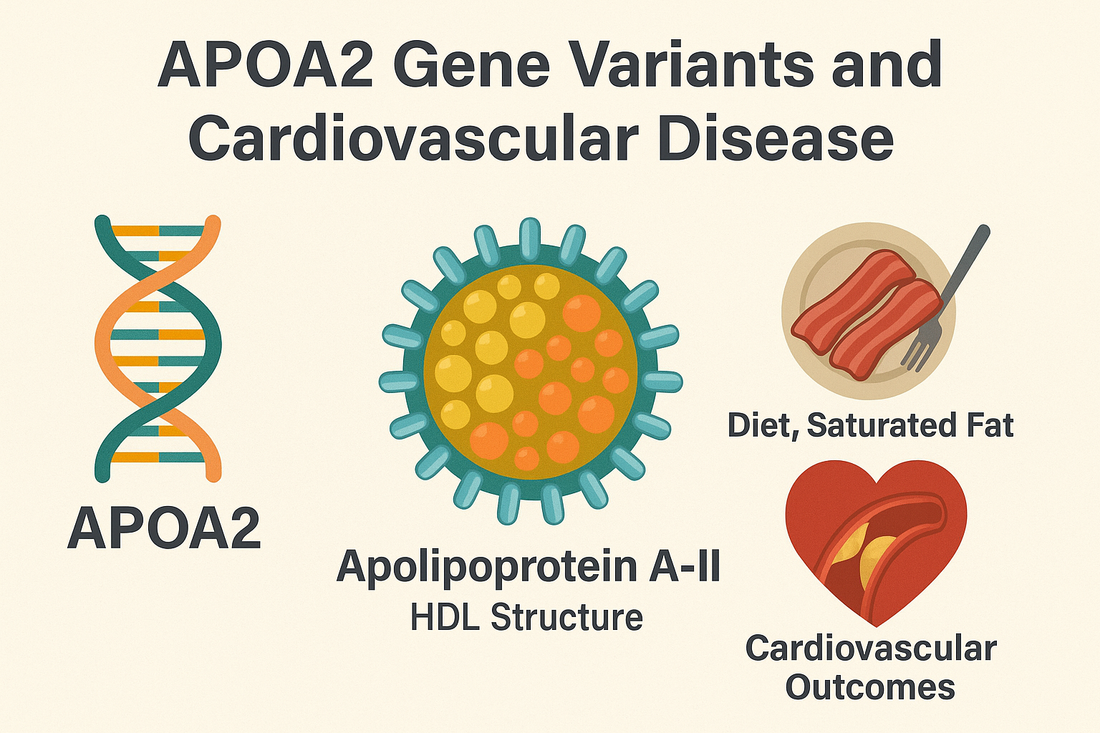APOA2: Gene Variants, HDL Function, and Cardiovascular Risk
Introduction
The APOA2 gene encodes apolipoprotein A-II (ApoA-II), the second most abundant protein in high-density lipoproteins (HDL). While APOA1 provides structural integrity and functional capacity to HDL, ApoA-II fine-tunes HDL metabolism, lipid transfer, and interactions with enzymes such as lipoprotein lipase (LPL), hepatic lipase, and CETP (cholesteryl ester transfer protein).
Variants in APOA2 can significantly alter HDL composition, triglyceride metabolism, obesity susceptibility, and cardiovascular disease (CVD) risk. Understanding how these variants affect lipid biology helps us design personalized strategies through CardiaX testing.
Role of APOA2 in Lipid and Cardiovascular Biology
-
HDL metabolism: ApoA-II stabilizes HDL particles but in excess may make them dysfunctional.
-
Triglyceride regulation: Influences lipolysis and clearance of triglyceride-rich lipoproteins.
-
Obesity modulation: Certain APOA2 variants interact with diet—especially saturated fat intake—to influence obesity and metabolic syndrome risk.
-
Atherogenesis: Altered ApoA-II levels can impair reverse cholesterol transport, promote inflammation, and accelerate plaque formation.
Key APOA2 Variants
−265T>C (promoter region, rs5082)
-
CC genotype carriers: Increased risk of obesity, insulin resistance, and higher CVD risk—especially when consuming high-saturated-fat diets.
-
TT/TC genotypes: More neutral metabolic profiles.
Rare missense mutations
-
Affect ApoA-II structure, leading to abnormal HDL particles with reduced cardioprotective function.
How APOA2 Variants Impact Cardiovascular Risk
-
Obesity and metabolic syndrome: CC genotype at rs5082 predisposes to weight gain on high-saturated-fat diets, amplifying hypertension and dyslipidemia risk.
-
Dysfunctional HDL particles: Excess ApoA-II can displace ApoA-I, impairing reverse cholesterol transport and antioxidant function.
-
Triglyceride metabolism disruption: Poor clearance of triglyceride-rich lipoproteins worsens atherogenic dyslipidemia.
-
Inflammation: Altered ApoA-II modulates cytokines, raising systemic inflammation and endothelial dysfunction.
What Increases Risk with APOA2 Variants?
-
High saturated fat intake (butter, fatty meats, dairy).
-
Obesity and visceral adiposity.
-
Insulin resistance, type 2 diabetes, metabolic syndrome.
-
Sedentary lifestyle and chronic inflammation.
-
Smoking and oxidative stress.
How to Mitigate APOA2-Associated Risk
1. Lifestyle Modifications
-
Diet:
-
Limit saturated fat to <7–8% of calories for those with the CC genotype.
-
Focus on Mediterranean patterns: olive oil, nuts, fatty fish, legumes, and vegetables.
-
Increase fiber intake (30+ g/day) to improve insulin sensitivity and lipid clearance.
-
Minimize processed carbs and excess alcohol to reduce triglycerides.
-
-
Exercise:
-
At least 150 minutes/week of moderate aerobic exercise.
-
Add strength training to improve insulin sensitivity and body composition.
-
-
Weight management:
-
Target 5–10% reduction in body weight if overweight or obese.
-
2. Nutraceuticals
-
Omega 1300 — Omega 1300: Improves triglycerides and HDL function.
-
CoQ10 Omega — CoQ10 Omega: Enhances endothelial health and mitochondrial function.
-
Curcumin Complex — Curcumin Complex: Anti-inflammatory and antioxidant.
-
Magnesium: Supports insulin sensitivity and vascular function.
-
Green tea extract: Helps reduce visceral fat and improves lipid metabolism.
-
N-acetylcysteine (NAC): Supports glutathione synthesis, protecting ApoA-II and HDL from oxidation.
3. Peptides
-
MOTS-c: Improves mitochondrial efficiency and helps regulate weight and glucose metabolism.
-
BPC-157: Supports endothelial repair and reduces vascular inflammation.
-
GLP-1 agonist peptides: Beneficial in obesity and insulin resistance contexts.
4. Medications
-
Statins and ezetimibe: Lower apoB-containing lipoproteins.
-
PCSK9 inhibitors: For patients with elevated LDL and high risk.
-
GLP-1 receptor agonists / SGLT2 inhibitors: For obese or diabetic patients, reduce weight and improve lipid profiles.
-
Icosapent ethyl (EPA): High-dose omega-3 for patients with persistent hypertriglyceridemia.
Case Example
A 52-year-old male with APOA2 CC genotype, BMI 31, TG 225 mg/dL, HDL-C 42 mg/dL, apoB 115 mg/dL. Diet high in red meat and butter.
Plan:
-
Mediterranean diet with reduced saturated fat, increased fiber.
-
Omega 1300, CoQ10 Omega, Curcumin Complex, NAC.
-
Initiated MOTS-c peptide to improve weight management.
-
Statin plus ezetimibe for apoB reduction.
-
3-month follow-up: Weight down 7%, TG 142 mg/dL, apoB 78 mg/dL, HDL function improved.
The Bottom Line
APOA2 gene variants, especially the rs5082 CC genotype, interact strongly with diet and lifestyle. They influence HDL quality, triglyceride metabolism, obesity, and overall cardiovascular disease risk.
With CardiaX testing, clinicians can identify APOA2-related vulnerabilities and implement tailored dietary adjustments, nutraceuticals, peptides, and medications to reduce CVD risk.
References
-
Corella D, et al. APOA2 gene promoter polymorphism and saturated fat intake modulate obesity and heart disease risk. Am J Clin Nutr.
-
Pownall HJ, et al. Roles of apolipoprotein A-II in lipoprotein metabolism and cardiovascular disease. Curr Opin Lipidol.
-
Ordovas JM, et al. Gene-diet interactions in cardiovascular disease risk: focus on APOA2. Nutr Rev.
-
Gordon SM, et al. Dysfunctional HDL: implications for apolipoproteins in cardiovascular disease. Arterioscler Thromb Vasc Biol.


